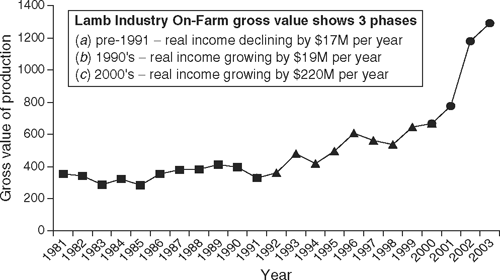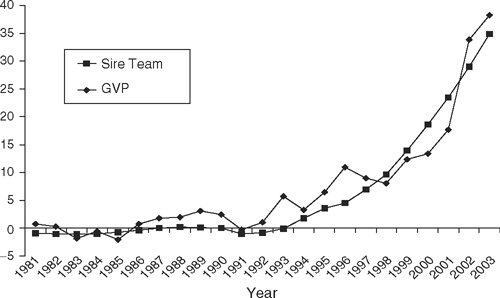Genetic improvement of lamb—industry issues and the need for integrated research
D. W. Pethick A D , R. D. Warner B and R. G. Banks CA Division of Veterinary and Biomedical Sciences, Murdoch University, Murdoch, WA 6150, Australia.
B Department of Primary Industries, 600 Sneydes Road, Werribee, Vic. 3030, Australia.
C Meat and Livestock Australia, Locked Bag 991, North Sydney, NSW 2059, Australia.
D Corresponding author. Email: d.pethick@murdoch.edu.au
Australian Journal of Agricultural Research 57(6) 591-592 https://doi.org/10.1071/ARv57n6_PR
Published: 20 June 2006
Abstract
This paper provides an introduction to the special edition of the Australian Journal of Agricultural Research dedicated to an integrated research program to understand the effects of genetic selection for live animal traits (growth, muscle, and fatness) that determine carcass and meat attributes. Combined with this are the effects of nutritional status of the dam and growing lamb. The reasons for, and general approach of, the research is outlined.
Introduction
The Australian lamb and sheep meat industry via the Sheep Industry Strategic Plan has placed a high priority on investigation of methods to consistently deliver lamb carcasses that meet a need for increased size, less fat, and more muscle. Combined with this is the need for the meat to have a high eating quality and attractive visual appeal to consumers.
There are a number of imperatives driving the need for clear definition and improvement of production efficiency, carcass quality, and eating quality in lamb: (i) on-farm terms of trade have, over the last 40 years, decreased by about 2.2% per annum (ABARE 2003) and improvements in efficiency (faster growth, less fat more muscle) are critical to address long-term profitability; (ii) overseas markets in America have emerged as a significant driver of the Australian industry (McGovern and McAlister 2005) and large lean carcasses are preferred; (iii) the small size of lamb cuts makes seaming of muscles to remove intermuscular fat an expensive boning procedure and fatter carcasses require more preparation time (Hopkins et al. 1995); (iv) consumers have in the past consistently perceived lamb as too fatty; and (v) consumer expectations of premium quality and value for money are increasing.
There is a paucity of research into sheep meat breeds that attempts to understand the interactions of specific genetic selection indices on lamb performance, carcass composition, and meat quality. Considerable work in cattle suggests that extreme selection can have pronounced positive effects on growth potential and carcass quality, but at the same time there are positive and negative effects on meat quality (Pethick et al. 2005). This special edition describes work based around a single experiment which has combined traditional measures of growth and carcass quality with many other areas of biology and meat science in an attempt to better understand: (i) the commercial and biological mechanisms underpinning genetic selection for growth and carcass traits as they interact with nutritional regime, and (ii) the effects on muscle structure including cellularity, metabolic biochemistry, and gene expression.
The core experiment was established to understand the commercial consequences of selection for growth and muscling as practised in Australian terminal sire sheep breeds starting in 1988 with the implementation of LAMBPLAN (Banks 1994). A key feature of the experiment described in this special edition was that estimated breeding values (EBVs) were used to sample sires representing 3 different biological types: (i) animals selected for rapid growth for age (G), and with close to population average genetic merit for fatness and muscling prior to selection; (ii) animals less highly selected for growth but more heavily muscled (M), and slightly genetically leaner than the population average prior to selection; and (iii) animals representing the population average in 1990 (C).
The sires were selected from within the Australian Poll Dorset breed, and all their EBVs can be compared directly, so the experiment reported here investigated the consequences of different selection strategies and responses in terms of growth and maturity pattern. Statistical analyses typically included all 3 sire EBVs for post weaning weight, fat depth, and eye muscle depth. This genetic contrast was overlaid with a nutritional comparison. One of the important outcomes of the body of work is the demonstration that simple genetic tools (EBVs) can be used successfully to set up such contrasts, and provide a rich platform for a range of linked investigations. Importantly the work was underpinned with a clear commercial focus. The genetic contrasts (growth, fatness, and muscle) within the terminal sires were chosen from Australian terminal sire breeders, and the nutritional contrasts were constructed utilising differential extensive pasture management. Finally, a focus group of commercial prime lamb producers helped manage and direct the ‘on-farm’ components of the project.
Genetic selection of terminal sires in Australia
Genetic improvement is traditionally seen as a long-term investment to improve the efficiency of animal growth and the economic value of the product to the whole supply chain. Importantly, there is clear evidence that genetic gains can also be realised within short time frames provided the targets are clear and valued by the supply chains. Banks (2003) has discussed the evolution of the Australian prime lamb industry from the 1980s. The industry was floundering during the 1980s and early 1990s and began to recover slowly later in the 1990s. However, the period 2000 and beyond has seen the industry experience exceptional growth (Fig. 1).

|
Banks (2003) showed that genetic improvement for carcass weight and leanness of terminal sires delivered under LAMBPLAN was closely matched to the 2000 boom in value of the lamb industry (Fig. 2). Genetic improvement is just one component of the story, but a very significant one—productivity and product quality trends in the lamb industry due to genetic improvement have been running at just on an average 4% per year since the late 1990s. Genetic improvement has been very important in allowing production of the larger, leaner lambs that customers want (the industry could not produce lean lambs heavier than about 19–20 kg before 1990).

|
The important message is not just that genetic improvement in a livestock industry is fundamental to industry profitability, but that converting the genetic improvement into improved returns requires a whole-of-industry approach. This has meant a need for improvements in farm management, genetics, and marketing, and a consumer-focused industry. Given this broader approach, the Industry expressed a desire to understand the effects of different nutritional overlays. Of particular interest was the role of nutrition on the expression of the genetic potential and also on product and carcass quality. Additionally, the Industry also wished to understand the effects of genetic selection for carcass traits on subsequent lamb meat quality. Finally, the work associated with the core experiment complements selection experiments reported overseas and summarised in this special edition (Lewis et al. 2006).
Hopkins DL,
Wotton JSA,
Gamble DJ,
Atkinson WR,
Slack-Smith TS, Hall DG
(1995) Lamb carcass characteristics 1. The influence of carcass weight, fatness and sex on the weight of trim and traditional cuts. Australian Journal of Experimental Agriculture 35, 33–40.
| Crossref | GoogleScholarGoogle Scholar |

Lewis RM,
Emmans GC, Simm G
(2006) Describing effects of genetic selection, nutrition, and their interplay in prime lambs using growth and efficiency functions. Australian Journal of Agricultural Research 57, 707–719.



